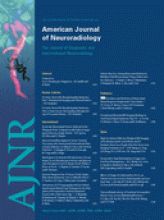The editorial, “Death by Nondiagnosis,” advances the argument that CT angiography (CTA) should not be used in the setting of subarachnoid hemorrhage.1 The authors based their argument on a back-of-the-envelope calculation derived from data of 2 abstracts of presentations at the 2006 American Society of Neuroradiology meeting. One of the abstracts is from the University of Washington (UW) and the other from the University of Maryland (UM).
Using a calculated false-negative rate of 10% adapted from those abstracts and then applied to statistics from totally different populations mashed with some other assumptions, the authors conclude that we might expect an excess death rate of 2.5% from the use of CTA. The authors contrast their calculated false-negative rate of CTA with a 0% false-negative rate for conventional angiography. The argument is seriously flawed.
The UW study reported that most of the missed aneurysms were incidental ones, that is, smaller aneurysms in patients with multiple aneurysms whose bleeding aneurysm was correctly identified. To rework the UW data, 4 patients in a total of 158 patients with aneurysms underwent treatment of aneurysms that were not detected on the CTA but only on the digital subtraction angiography (DSA). On my envelope, that is a clinically relevant false-negative rate of 2.5%.
The UM abstract refers to a different population. Some were scanned for the diagnosis of subarachnoid hemorrhage but some for “suspected intracranial aneurysm.” From the information in the abstract, one cannot determine the false-negative rate for the detection of the bleeding aneurysm (when there was a bleed), but one can presume that it would be a lot less than the nearly 10% that they reported overall. As with the UW group, many of the patients in whom an aneurysm was missed were patients with multiple aneurysms. Aneurysms that bleed tend to be larger than aneurysms that do not.
It is a statistical sleight of hand to compare the sensitivities of 2 examinations (CTA versus DSA) in a setting where one study (CTA) is always occurring before the second (DSA). An article by Lubicz et al, reviewing their experience with 64-row CT visualization of aneurysms in the same issue of the American Journal of Neuroradiology as the editorial, makes note of the fact that, in retrospect, all of the aneurysms in their series were visible after the DSA was available.2 This is to say that had CTA followed DSA, the sensitivity of CTA would be 100%. As a sidelight, none of the missed aneurysms on the original CTA reads described in the article by Lubicz et al were aneurysms that bled.
The interesting question raised by the UW and UM studies is exactly why the aneurysms are missed on CTA in the first place. The UW study emphasizes the size of the aneurysm (small ones tend to get missed), whereas the UM study emphasizes decreased accuracy in arteries adjacent to bone (primarily anterior clinoid). Neither of these particular studies seems to evaluate whether these aneurysms are detectable in retrospect (as such, representing potentially correctable failures of interpretation) and in which cases these are aneurysms simply not visible on the examination. It is important when reporting on its accuracy that attention be placed on exactly how technically satisfactory the study is. The most important issue is not what protocol is in place at a given institution but what was achieved in a particular case. The greatest variable in the quality of a head CTA is the Hounsfield value that is achieved in the circle of Willis arteries. This ranges from approximately 150 to 450 with some of this related to technique and much of this related to the individual patient. Values lower than perhaps 250 start to become problematic.
The key thing is that, since the interpreting radiologist knows this information, decisions relating to the CTA can be tempered by the quality of the individual examination rather than by applying some statistic from a large group. The other important factor is that the interpreting radiologist be adept at the use of a good workstation for 3D and multiplanar reconstructions, that the radiologist be familiar with the pitfalls of CTA, and that the radiologist is willing and able to spend the time to extensively review the images.
The UM study describes problems related to the proximity of the anterior clinoid, which can affect the visualization on 3D imaging but does not cause much confusion on multiplanar image interpretation. The UW study describes missing 9 aneurysms in the 4- to 10-mm range, which I can only believe is related to avoidable interpretive error or significantly compromised quality of the individual study. It is rare for an aneurysm over 2 mm in size to be “invisible” on a good-quality CTA. Many CTA errors are related to environments in which the interpreting radiologists are not facile with a workstation and in which, for any number of reasons, the radiologist does not spend enough quality time reviewing the study. More retrospective review and analysis of which “missed” CTA cases are avoidable, either by better techniques or by better radiologist training, is in order before throwing out CTA in the evaluation of subarachnoid hemorrhage.
References
- Copyright © American Society of Neuroradiology












